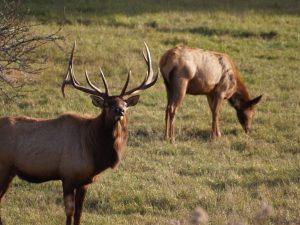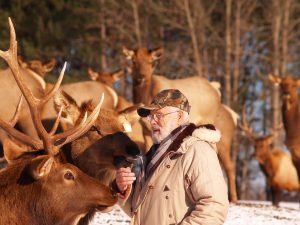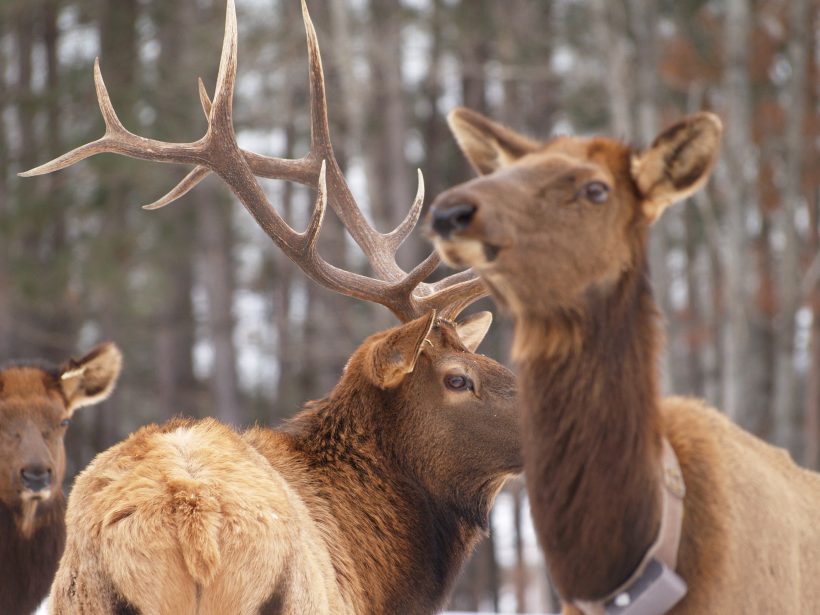THE ELK COMETH
The primary site chosen to house the elk was Ginn Lake in Mayo Township. John O’Donnell, Co-Chair of the York River Chapter of the Rocky Mountain Elk Foundation (RMEF) explained that the marsh and conifer cover was ideal for elk. The compound site features a fresh water creek, good hemlock cover and isolation. The communities of Blind River and Kenora were also competing for the elk reintroduction. In his outdoor column of February 17, 1999 in the Toronto Star, John Power wrote: “We’re told that the Bancroft area is on top of the list for next year’s reintroduction.” On March 5 Power told The Bancroft Times “I have heard Bancroft’s name mentioned a lot. I do think your area will get the next release of elk.” (Gin Lake is located east of Bancroft.)
Following the announcement that elk would be released at Gin Lake the Bancroft Elk Restoration Committee as it was now called began work on an old logging road from the 70s leading to the compound where the elk would be housed prior to their release. The Northern Outdoor Studies class (NOS) from North Hastings High School in Bancroft under the supervision of their teachers Bob Shouldice and Steve Burbidge brushed and widened the trail leading to the elk compound.
In December staff at Elk Island National Park rounded up the 50 adult elk and 20 calves for testing of diseases such as avian tuberculosis. Elk Island’s Rob Kaye, senior park warden, said, “We ensure the elk are not carrying any diseases before relocating them.” He offered the example of a soon to be release in the Great Smokey National Park in Tennessee and North Carolina. ‘Testing of the animals there has been ongoing for two and a half years,” he said. On December 27, 1999, the Local Implementation Committee (LIC) received the health clearance from Ottawa. The elk convoy would take some 30 hours to travel the 3700 km to Ginn Lake. In fact, after an absence of 50 years, the elk arrived at Gin Lake at 11:30 a.m., on Sunday January 10, approximately 48 hours after their departure from Elk Island. Veterinarian Ernie Mackey pronounced the “animals in good health.”
As mentioned earlier the initial plans were to house the elk in a compound for 4-6 weeks but almost immediately the adults were jumping the 10 foot walls. (By comparison, an official basketball hoop is 10 feet off the ground.) For safety reasons and quick access to food and water one wall was removed. Helpers distant from the actual release site were surprised to see wild elk running their way. In spite of the best made plans nature once again served up another helping of humble pie reminding us that “to err is human; to moo is bovine.”

January proved to be the elk reintroduction month, first at Gin Lake (east of Bancroft) and then near Kenora at remote Cameron Lake on January 18, 2000, where initially 34 cows, I bull and 13 calves (of which 7 are bulls) were unloaded. Twelve more bulls were expected. Since the release of 70 elk at Gin Lake there have been two fatalities. An autopsy at the University of Guelph revealed that a pregnant cow, discovered on January 14, four days after the release, had an old broken rib injury as well as newly broken ribs. The cause of death was due to internal injuries possible due to the rib breaks Just when that happened couldn’t be determined. Then an injured bull was discovered on Weslemkoon Lake. Dr. Mackey (vet) diagnosed a broken right shoulder and had to euthanize it. Apparently the bull lost its footing over an ice ridge and pulled all of its ligaments in the rear legs when it “spread eagled” on the lake ice. Both animals were sent to the MNR research facility at Trent University in Peterboro and from there on to Guelph for further study. The majority of the elk remained around their release site although some did wander far afield. One bull, for instance, traveled a widely circling to Paudash, Wilberforce, and Maynooth before returning to the release site. Researchers have been surprised that the elk have wandered as far away as Belleville, Haliburton, Huntsville, Renfrew, Port Hope and western Quebec. This was something of a surprise for when Bancroft became involved in the elk re-introduction project, committee members were told that the elk would travel about 50 kilometres. As Chicken Man used to exclaim (I believe): “They’re everywhere. They’re everywhere.” In fact some of them may be bugling that old Hank Snow tune “I’ve been everywhere man.” A Ministry of Natural Resources news release of February 18, 2000 stated that further transfers of elk to the Bancroft area are planned to bring the herds to between 100 and 200 animals – “a range needed to establish sustainable herds.”

